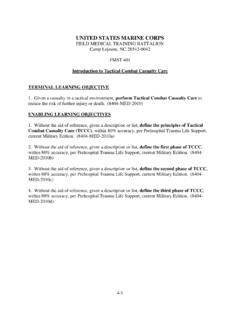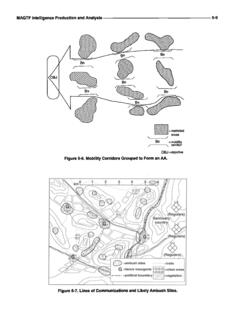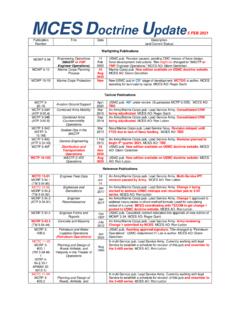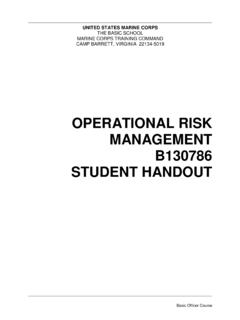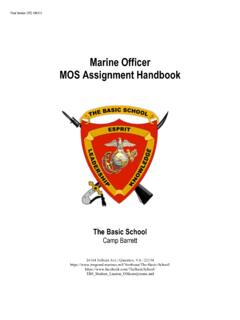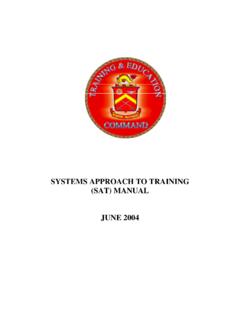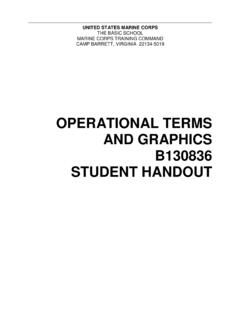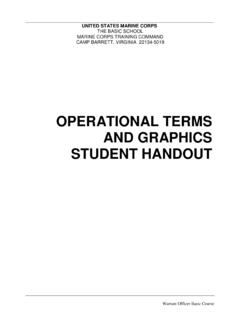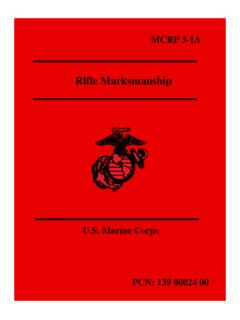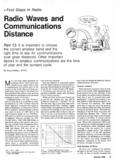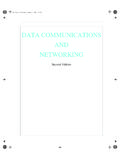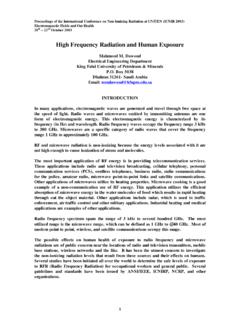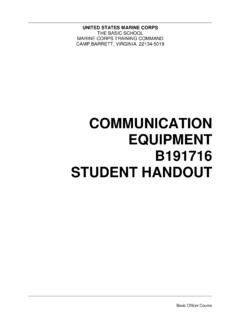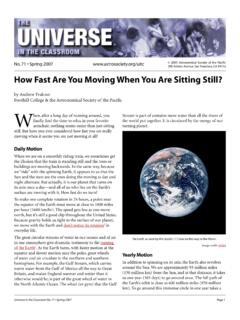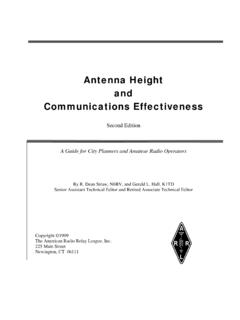Transcription of RADIO OPERATORS HANDBOOK
1 MCRP FMFM 3-36. RADIO OPERATORS . HANDBOOK . Marine Corps PCN 144 000067 00. Page 1 Friday, June 25, 1999 10:49 AM. RADIO Operator's HANDBOOK Table of Contents Page Chapter 1. RADIO Principles Section I. Theory and Propagation Basic Components of RADIO Equipment 1-2. RADIO waves 1-3. RADIO Wave Propagation 1-6. Section II. Modulation and Single Side Band Transmission Modulation 1-14. Single Side Band Transmission 1-16. Chapter 2. Single-Channel RADIO Single-Channel RADIO Communications Equipment 2-1. High Frequency RADIO 2-2. Very High Frequency RADIO 2-6. Ultrahigh Frequency RADIO 2-11. Data Communications 2-15. Chapter 3. Equipment Siting and Grounding Techniques High Frequency 3-1.
2 Very High Frequency and Ultrahigh Frequency 3-3. Grounding Techniques 3-10. Data Communications 2-15. Chapter 4. Antennas High Frequency Antennas 4-1. Very High Frequency Antennas 4-6. Antenna Length 4-7. Page 2 Friday, June 25, 1999 10:49 AM. _____ MCRP 6-22C. Chapter 5. Interference Natural Interference 5-1. Manmade Interference 5-1. Poor Equipment Condition and Improper Usage 5-2. Frequency Interference and Intermodulation 5-2. Use of Unauthorized Frequencies 5-3. Frequency Reuse 5-3. Chapter 6. RADIO Operations Under Unusual Conditions Operations in Desert Areas 6-1. Operations in Jungle Areas 6-3. Operations in a Cold Weather Environment 6-5. Operations in Mountainous Areas 6-9.
3 Operations in Special Environments 6-9. Chapter 7. Electronic Warfare Electronic Attack Techniques 7-1. Electronic Protection Techniques 7-6. Electronic Warfare Support Techniques 7-10. Appendices A Map Coordinates A-1. B Time Zones B-1. C Prowords C-1. D Phonetic Alphabet D-1. E Phonetic Numerals E-1. F Prosigns F-1. G Instructions for Preparing Field Messages G-1. H RADIO Log H-1. I Metric System Conversion Table I-1. J Authentication J-1. K International Morse Code K-1. L Frequency Prediction Means L-1. M Position and Navigation Systems M-1. N Size of Dipole and Inverted L Antennas N-1. O Field Repair and Expedients O-1. P RADIO Operator's Checklist P-1. Q Glossary Q-1. R References and Related Publications R-1.
4 Chapter 1. RADIO Principles Communications and information systems (CIS) are any systems whose primary functions are to collect, process, or exchange information. The fundamental requirement is to provide the Marine air-ground task force (MAGTF) commander with a reliable, secure, fast, and flexible commu- nications network. Communications and information systems automate routine functions, thereby freeing commanders and staffs to focus on those aspects of com- mand and control that require experience, judgment, and intuition. These systems and the personnel who install, operate, and maintain them play a key role in the command and control of the MAGTF. Communi- cations and informations systems support the commander and every staff section in every phase of operations planning and execution.
5 These systems facilitate information flow throughout the MAGTF and provide shared situational awareness, informed decisionmaking, and rapid dissemination of decisions. The success of the MAGTF in the modern battlespace depends on the effective employment of communications and information systems. Single-channel RADIO (SCR) is one of the most important components of MAGTF CIS. _____. 1-2 MCRP 6-22C. Section I. Theory and Propagation BASIC COMPONENTS OF RADIO EQUIPMENT. The RADIO equipment for communication between two stations and the path the signal follows through the air is called a RADIO link. A RADIO link consists of seven components: the transmitter, power supply, transmis- sion lines, transmitting antenna, propagation path, receiving antenna, and receiver (see figure 1-1).
6 The transmitter generates a RADIO signal. The power supply ( , battery or generator) supplies power for the operating voltage of the RADIO . The transmission line delivers the signal from the transmitter to the antenna. PROPAGATION. PATH. TRANSMITTING RECEIVING. ANTENNA ANTENNA. TRANSMISSION. LINES. POWER. SUPPLY. TRANSMITTER RECEIVER. Figure 1-1. RADIO Link. _____. RADIO Operator's HANDBOOK 1-3. The transmitting antenna sends the RADIO signal into space toward the receiving antenna. The path in space that the RADIO signal follows as it goes to the receiving antenna is the propagation path. The receiving antenna intercepts or receives the signal and sends it through a transmis- sion line to the receiver.
7 The receiver processes the RADIO signal so the human ear can hear it. When transmitting, the RADIO operator aims to provide the strongest pos- sible signal at the site of the receiving station. The best possible signal is that signal which will provide the greatest signal-to-noise ratio at the receiving antenna. To transmit the best possible signal, select or determine the . l Optimum frequency. l Best antenna for that frequency based on the available space of the transmitting site. l Proper propagation path. RADIO waves . Propagation Velocity (Speed). RADIO waves travel near the surface of the Earth and radiate skyward at various angles to the Earth's surface. These electromagnetic waves travel through space at the speed of light, approximately 300,000 kilo- meters (km) or 186,000 miles (mi) per second.
8 Wavelength Wavelength is the distance between the crest of one wave and the crest of the next wave (see figure 1-2 on page 1-4). It can also be the length of one complete cycle of the waveform. It is also the distance traveled dur- ing one complete cycle. The length of the wave is always measured in meters. _____. 1-4 MCRP 6-22C. ONE CYCLE. WAVELENGTH. PEAK. STRENGTH 0. PEAK. TIME OR DISTANCE. Figure 1-2. RADIO waves . RADIO Frequency The frequency of a RADIO wave is the number of complete cycles that occur in one second. The longer the cycle, the longer the wavelength and the lower the frequency. The shorter the cycle, the shorter the wave- length and the higher the frequency. Frequency is measured and stated in units called hertz (Hz).
9 One cycle per second is stated as 1 hertz. Because the frequency of a RADIO wave is very high, it is generally mea- sured and stated in thousands of hertz (kilohertz [KHz]) or in millions of hertz (megahertz [MHz]). One KHz is equal to 1,000 cycles per second, and 1 MHz is equal to a million cycles per second. Sometimes frequen- cies are expressed in billions of hertz (gigahertz [GHz]). One GHz is equal to a billion cycles per second. For practical purposes, the velocity of a RADIO wave is considered to be constant, regardless of the frequency or the amplitude of the transmitted wave. Therefore, to find the frequency when the wavelength is known, divide the velocity by the wavelength.
10 Frequency (hertz) 300 million (meters per second). =. Wavelength (meters). To find the wavelength when the frequency is known, divide the velocity by the frequency. Wavelength (meters) 300 million (meters per second). =. Frequency (hertz). _____. RADIO Operator's HANDBOOK 1-5. RADIO . VISIBLE. IR UV X-RAY GAMMA- COSMIC- VHF RAY RAY. UHF. HF. 3G. 3M. 30. 30. 0M. MH. Hz Hz Hz z Figure 1-3. Electromagnetic Spectrum. Within the RADIO frequency spectrum (see figure 1-3), RADIO frequencies are divided into groups or bands of frequencies. The RADIO frequency spectrum is part of the electromagnetic spectrum. Most tactical RADIO sets operate within a 2- to 400-MHz range within the frequency spectrum.
